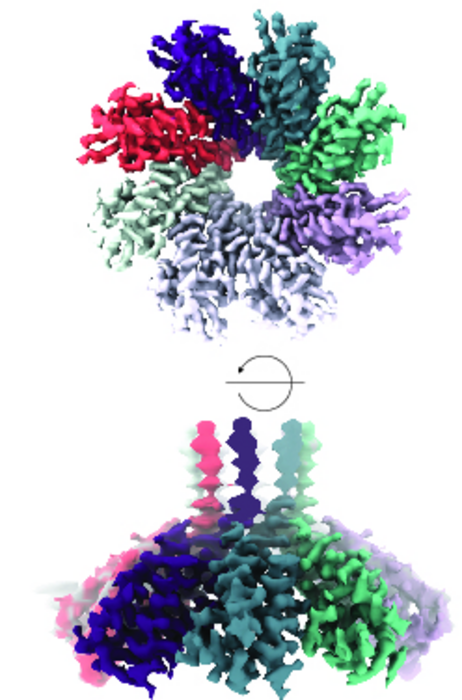CRISPR claimed scientific fame for its ability to quickly and accurately edit genes. But, at the core, CRISPR systems are immune systems that help bacteria protect themselves from viruses by targeting and destroying viral DNA and RNA. A new study published in Science reveals a previously unrecognized player in one such system – a membrane protein that enhances anti-viral defense – simultaneously broadening our understanding of and raising more questions related to the complexities of CRISPR.

Credit: University of Rochester Medical Center
CRISPR claimed scientific fame for its ability to quickly and accurately edit genes. But, at the core, CRISPR systems are immune systems that help bacteria protect themselves from viruses by targeting and destroying viral DNA and RNA. A new study published in Science reveals a previously unrecognized player in one such system – a membrane protein that enhances anti-viral defense – simultaneously broadening our understanding of and raising more questions related to the complexities of CRISPR.
Uncovering New Clues about CRISPR
CRISPR systems consist of two major components – a guide RNA that targets a specific viral DNA or RNA sequence and a Cas enzyme that cuts the targeted DNA or RNA, preventing a virus from replicating and spreading. A team at the University of Rochester Center for RNA Biology found that a specific Cas protein (Cas13b) not only cuts viral RNA, but communicates with another protein (Csx28) to augment its anti-viral defense.
In partnership with scientists at Cornell, the team discovered that the Csx28 protein forms a pore-like structure (i.e. it has a big hole in it). When they infected E. coli with a phage (virus that attacks bacteria) and deployed the CRISPR-Cas13 system to target and halt infection, they found that Cas13 signals to Csx28 to affect membrane permeability. Once this happens, Csx28 wreaks havoc in the infected cell, discombobulating membrane potential, crushing metabolism and hindering energy production. A virus can’t replicate under such unhospitable circumstances, leading to the team’s conclusion that Csx28 enhances CRISPR-Cas13b’s phage defense.
“This finding upends the idea that CRISPR systems mount their defense only by degrading RNA and DNA in cells and really broadens our view of how CRISPR systems may be working,” said corresponding author Mitchell O’Connell, PhD, assistant professor of Biochemistry and Biophysics at the University of Rochester Medical Center (URMC) and a member of the UR Center for RNA Biology. “When we think about CRISPR, we see Cas proteins such as Cas9 or Cas13 as the big hammer doing all the damage, but that might not be the case; we found that Cas13 and Csx28 are working together to effectively extinguish a virus.”
“When you read this paper you think to yourself…‘what?’ This is such a weird mechanism and not the way I would have predicted that bacteria would work,” added John Lueck, PhD, assistant professor of Pharmacology and Physiology at URMC. “It is really impressive that the team identified this pore-like protein that doesn’t resemble anything else we’ve seen before, and now that we know that this mechanism exists people will start to look for it in other systems. This is exciting because in science, when you scratch the surface, you often find that there is an entirely new world behind it.”
More Questions than Answers
With the added knowledge of the structure of Csx28 through the use of high-resolution cryo-EM, the team is beginning to probe the function of the protein. Questions abound. If the goal is protection, why is there a giant hole in the membrane? The team found that when Cas13 isn’t around, Csx28 isn’t active. What makes it become active in defense? How long does it stay active and what does it let through the membrane? Understanding the biochemistry behind the opening and closing of the pore will shed light on how CRISPR-Cas13 uses it as part of its defense and provide a jumping off point for the study of membrane proteins across other CRISPR systems.
“This finding is unexpected and raises all kinds of new questions about how bacteria protect themselves and what they are doing to survive infection,” noted Mark Dumont, PhD, a professor of Biochemistry and Biophysics at URMC who has spent his career studying membrane proteins. “It is also a very interesting interface between RNA biology, CRISPR, structural biology and membrane biology. While there is no immediate medical relevance or application, the ideas that boil up from this could be very powerful.”
Lueck adds, “It is very rare for one study to have this many thought-provoking pieces that it brings several different fields together. And because the concepts are brand new, future work won’t be burdened by dogma. Any time people can bring fresh, unfettered ideas to the table it is really good for science.”
In addition to O’Connell, lead study author Arica VanderWal, PhD, a former graduate student in O’Connell’s lab who is now a postdoctoral researcher at UC San Diego, contributed to the research. Graduate students Julia K. Nicosia and Adrian M. Molina Vargas in the O’Connell lab, Bogdan Polevoda, PhD, research assistant professor of Biochemistry and Biophysics at URMC, and Elizabeth Kellogg, PhD, and Jung-Un Park from the department of Molecular Biology and Genetics at Cornell University also supported the research. The study was funded by the National Institutes of Health.
Journal
Science
DOI
10.1126/science.abm1184
Method of Research
Experimental study
Subject of Research
Cells
Article Title
Csx28 is a membrane pore that enhances CRISPR-Cas13b-dependent anti-phage defense
Article Publication Date
27-Apr-2023




